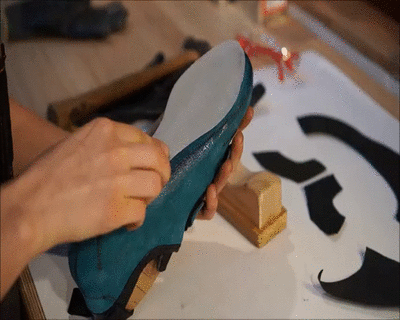]]>

Ever since the first SFT beta shoes were shipped, we’ve been branding the logo into the leather and then hand-inking it for contrast. These branded logos look lovely right out of the box, but the ink doesn’t last past the first resole. Maybe fine for the first prototypes, but clearly, it was time to reconsider the logo process.
Thinking about the logo as a subassembly (what kind of components generate the logo) rather than as a process to be improved (how do we make our ink more durable – that we already experimented with) opened up the possibilities. After considering design options, we decided on woven fabric labels. Unlike most of our other manufacturing steps, woven labels are a component best sourced from one of the many companies that already specialize in this. Last step: find a supplier to partner with – the first component-level link in our supply chain.
We found that the Dutch Label Shop offered the space for creativity and the commitment to durability that SFT wanted for our new woven labels. The first order turned out great, and we’re proud to incorporate them into our shoes.
]]>Bottom line, I’ve been staring at detailed footage of the build process for a single pair of shoes for hours. Days.

And it’s paid off. Not just because it’s coming together into a sweet little video, but because editing the video made me realize some things about how SFT builds shoes right now.
For example, no one wants to sit through watching glue dry on rubber for 20 minutes before I reactivate it to apply the rand to the shoe upper, so obviously that all gets cut from the raw footage. And everything that has to be cut, I’ve been looking at through the lens of process optimization – if I can be working on another component during that downtime, I can become more efficient as a craftsperson.
Another, less obvious lesson from video editing was how much time I spend with the glue container open. I’ve known for a while that the contact cement we use has a lifespan. I refuse to use glue over a couple of months old on components that see a lot of abrasion because an older glue bond has less peel strength than one made with fresh glue.
Since I’m constantly moving and conscious of my glue’s working time while painting it onto components, I assumed that the glue in the can wasn’t open to the air (and therefore aging) for longer than could be helped. It was shocking to see how much of the total video footage included an open can of glue! Fortunately, there’s a product called a cement pot that can help reduce the amount of glue exposed to air and the duration of that exposure, so I’ve finally purchased one. Maybe I’ll film another shoe assembly once I have the cement pot to check how much this improves the process and material usage.

While large factories have best practices and processes for process optimization, for me as a craftsperson building shoes at the same time as building SFT Climbing, there’s not always a lot of time for reflection on how everything gets done. But when I approach every task with both the immediate goal as well as how it fits into the larger picture in mind, I can almost always find some way to improve the overall process or product. Because we are all cross-function team members at SFT, manufacturing got to see itself in the mirror held up by marketing’s raw video footage, and our glue bonds will be stronger because of that.
]]>
We now offer 5.10 rubber as an option for the soles of SFT shoes!
]]>Because our last model is parametric (its geometry is determined by a stored set of equations and relationships), it can adapt to accommodate different variations of foot proportions. This video shows how the last shape changes for a 5% increase in length and a 22% increase in width across the ball of the foot.
]]>
Having zig-zag stitch capability is critical to making comfortable climbing shoes because it enables abutted seams. The main seam on rock climbing shoes crosses the ends of one's toes right where the shoe touches the rock. With a normal, non-abutted seam, this would mean there would be more than 2 layers of fabric between one's toes and the rock, right where the most sensitivity is required. Abutted seams don't have any overlap, so the entire shoe has only one fabric thickness and no bulky seams.
]]>